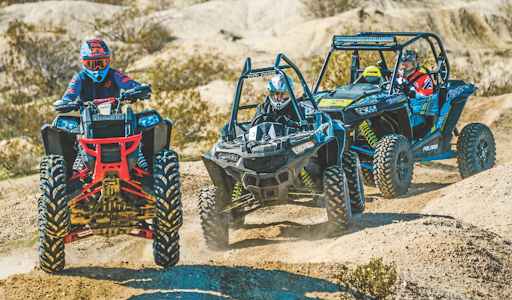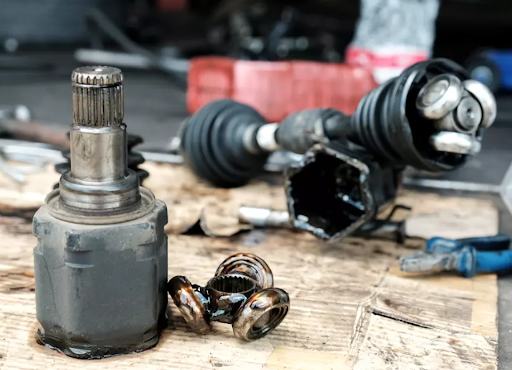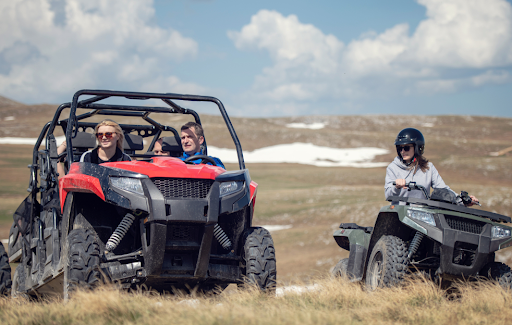7 minute read
Quad bikes have grown in size and power output, reach higher speeds, and offer better handling and all-terrain capability, but are also more prone to breakdowns. Higher performance takes its toll, with increased friction, heat and engine speeds all testing the limits of your machine. Some parts will last the lifetime of the bike, while others fail early on or need to be replaced more often.
Squarely in the second category are drivetrain parts, including quad bike axles, connected CV joints and boots and the belts that get them moving. Other parts, like spark plugs, brake pads and fluids, are all regular service items that ensure your quad runs as advertised. Getting issues fixed on time means staving off bigger repairs down the road. It also warrants that your ATV matches or exceeds stock performance numbers and that you get a quad ready for anything you throw at it.
ATV Axle Basics
Axles are directly involved in transferring engine power through the CVT transmission down to the wheels. While durable in stock form, they haven’t kept up with the rising power and torque numbers regularly seen in today’s bigger machines. This means more wear and frequent axle failure. Bigger side-by-side and sport ATVs can reach 200 hp and 150 Nm (110 ft-lbs) and redline over 10000 RPM.
Staggering numbers put additional stress on rotating components with more friction, higher heat levels and increased metal fatigue, all stretching even the thickest and strongest axle shafts to breaking point. Add lost lubrication from punctured CV boots, chipped or missing bearings, and joints battered through thick and thin to get you to your destination in style, and you risk bending, seizing, or snapping the axle right off the bike.
Recognizing Signs of Nearing Axle Failure
An abrupt or gradual loss of power when on the throttle is the first sign that something is wrong. This can be accompanied by popping or clicking sounds when negotiating turns, or increased vibrations through the bars or steering wheel. Other signs are the quad pulling to the side, or difficulties engaging reverse. Potential causes are ruptured CV boots, leaking grease increasing friction of moving metal assemblies, damaged or worn axle bearings and shot joint splines. Prolonged problems cause excess heat to bind, bend or warp the shafts, with the quad eventually stalling.
Why Have an Aftermarket Replacement
Aftermarket brands have long recognized the need for better-built and higher-quality quad bike parts than what comes fitted. Aftermarket quad bike axles come in heavy-duty and extreme-duty variants and as substantial upgrades in construction and materials compared to what you’d find even in top-of-the-range quads when new. There’s more heft with thicker shaft diameters optioned in heat-treated 5140 carbon steel for gains in tensile strength, and trace elements reducing wear and upping heat and abrasion tolerance. There’s also more elasticity and a lower risk of warping or deforming under loads or in technical terrain.
This is half of the picture. Thermoplastic boots are replaced with thicker, puncture-proof natural rubber or neoprene variants able to resist rocks and roots, industrial-grade bearings handle more weight and reduce rolling resistance; and line precision-machined joints for cleaner, faster power delivery. For the low asking price, you get a neat balance of increased strength, durability and performance.
Of course, spending more, especially on bigger and more capable machines, with extreme-duty axles brings further improvements. Here machined and heat-treated 4340 Chromoly steel, with higher nickel and molybdenum content raises the stakes in tensile, compressive and impact strength for increased durability at high speeds and increased loads. These are paired with CNC-machined joints lined with induction-treated bearings and covered with even thicker, heavy-duty boots. Bearings also include high-temp grease for smoother rolling. The few extra dollars over heavy-duty aftermarket axles guarantee parts that last longer, perform better and deliver more thrill in any ride.
Other ATV and UTV Upgrade and Replacement Options
Drive Belts
Axles work in tandem with drive belts located between the drive and driven clutch pulleys. Like axles, they’re some of the first parts to fail, largely due to subpar materials and cost-cutting. You’ll see issues popping up if you’re more eager on the throttle, work engines harder on inclines or when towing, and in harsher conditions with mud, water and debris eating away at the belt cogs, sidewalls and tensile cords. Belts can also fail due to misaligned pulleys, incorrect installation and too eager break-in. Power issues, jumpy acceleration and slippage are the key giveaway signs telling you to need a replacement.
Like aftermarket ATV and UTV axles, belts also come in tiered lineups for different uses and different quads. Low-to-mid displacement machines pushing 50hp at the wheels can benefit from heavy-duty belts that can stand more friction and heat. This is down to better cog and teeth designs and the use of uprated materials able to handle more elongation and impact when spinning at high speeds between the pulleys.
Bigger-engined quads regularly shred belts with higher torque and RPMs. For better performance and longevity, look for drive belts built around composite or synthetic tensile cords (like aramids or Kevlar), synthetic rubbers (chloroprene, ethylene, or diene) to reduce wear and damage, and fabric covers to prevent debris and water infiltration. They’ll handle higher power figures, more heat and last longer in typical rides involving high-speed trial runs, rock crawling or towing trailers.
Brake Pads
Brake pads are all about shorter stopping distances, better handling and negotiating safer turns. They’re subjected to harsh, abrasive environments that not only compromise safety but also increase wear. If the quad takes longer to get to a stop, you hear grinding sounds from the wheels, or the levers and pedals need more work, and time to replace the pads.
With most quads now featuring disc brakes front and rear, your choice of brake pads not only affects braking performance but also disc wear. Organic pads are easier on the discs and are generally quieter, but suffer from heavy braking. They also produce most dust. Choose these as cheap replacements for worn stock pads in everyday use and smaller bikes. For anything with more power and weight, there’s better performance with sintered or ceramic pads.
Sintered types often have the longest lifespans, but can be tough on the discs. They make up for this with more responsive braking, lower brake fade from high temperatures, and the best stopping power when warmed up. Ceramic pads are a viable but somewhat costlier alternative with matching performance when braking at high speeds, and significantly lower wear to discs and noise levels.
Air Filters
Much of the power the engine in your ATV or side-by-side produces is down to effective air intake systems. This consists of air filters and air boxes in different configurations and piping that pump cooled and cleansed air into the engine for combustion. For quad bikes, major issues arise with clogged air filters due to dust, mud and particles, and water ingress risking advanced parts wear. Corrosion and particles are enough to seize the engine and lead to expensive repairs.
For better filtration, choose from paper or foam filters in flat or cone designs, with a smaller micron rating to trap more contaminants and deliver higher air volumes at optimized angles and speeds when paired with equally capable airboxes.
All parts, from a range of various brands and in different price brackets, are available from specialized ATV and UTV parts retailers.







